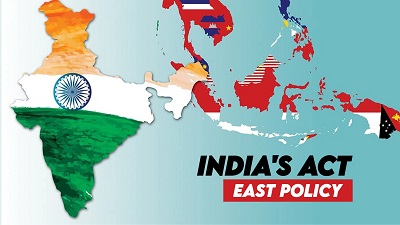Context-
India’s strategic focus on transforming its landlocked Northeast into a hub of connectivity with South and Southeast Asia lies at the heart of its 'Act East' policy. The creation of mega connectivity projects and economic corridors is pivotal for enhancing trade, fostering cultural exchanges, contributing to regional stability, and strengthening India’s geo economic influence in Southeast Asia. Central to this vision is the India–Myanmar–Thailand Trilateral Highway (IMT-TH), which is poised to be a game-changer in regional economic integration.
The India–Myanmar–Thailand Trilateral Highway
The IMT-TH is a significant connectivity project that aims to establish a seamless road link spanning approximately 1360 kilometers between India, Myanmar, and Thailand. The route begins in Moreh, India, passes through Tamu and Mandalay in Myanmar, and culminates in Mae Sot, Thailand. This highway is not just a road; it is a lifeline for economic growth, offering a streamlined route for trade, fostering foreign investment, and enhancing socio-economic ties between the connected nations.
Economic Impact
The IMT-TH holds the potential to significantly boost trade between India, Myanmar, and Thailand by providing a more efficient and cost-effective transportation route. India's exports to ASEAN, which rose to US$44 billion in 2022-23 from US$42.32 billion in the previous year, are expected to increase further. Although imports from ASEAN surged more significantly, reaching US$87.57 billion in 2022-23, the highway could help balance this trade by opening new markets and opportunities for Indian goods.
Moreover, the highway is set to facilitate not just trade but also education, tourism, and healthcare exchanges between the three nations, strengthening people-to-people connections and enhancing regional cooperation.
Regional Integration
Incorporating Bangladesh into the IMT-TH project transforms it from a trilateral initiative into a comprehensive regional network. This expansion enhances economic prospects by creating a corridor that links South Asia with Southeast Asia, promising to significantly reduce transportation costs and time. The integration could also provide access to markets in Nepal, Bhutan, and other regions, further aligning with the objectives of the Bay of Bengal Initiative for Multi-Sectoral Technical and Economic Cooperation (BIMSTEC).
This broader network is not just about economic benefits; it also holds strategic significance. The IMT-TH embodies India's vision of deeper regional integration and positions the country as a critical player in Southeast Asian geopolitics.
Challenges and Delays
Despite its potential, the IMT-TH project has faced significant delays and challenges since its inception in 2002. Initially targeted for completion in 2015, the deadline was extended to 2019, and now the new deadline is set for 2027. The primary reasons for these delays include political instability in Myanmar, financial constraints, and other regional impediments.
The 2021 military coup in Myanmar and the subsequent rise of the junta government have further paralyzed the project. The military’s grip on power has led to heightened violence and pervasive unrest, severely compromising the safety of construction workers and travelers. The ongoing conflict between the military junta and resistance groups, such as the National Unity Government and various ethnic armed organizations, has created a volatile atmosphere, significantly disrupting project timelines and escalating risks.
Security Concerns
Ensuring the safety of the highway and its users is paramount to the project’s success. This requires addressing the security challenges posed by the conflict in Myanmar and the ethnic tensions in India’s Northeast. The regions along the highway are home to numerous ethnic groups with longstanding disputes, complicating both the construction and maintenance of the highway.
In Myanmar, considerable security issues persist in the Chin State and Sagaing Region, where conflicts between the junta and ethnic armed groups continue to disrupt progress. In India’s Northeast, recent communal conflicts, such as those between the Kuki and Meitei communities in Manipur, have further strained the project’s progress.
One of the significant bottlenecks in the project is the replacement of 69 bridges along the Tamu-Kyigone-Kalewa road, which has been delayed since 2015 due to contractor agreement issues. Additionally, the construction of the Yar Gyi road section, where workers must navigate steep gradients and sharp curves, is only about 25% complete. Converting a 121.8-kilometer portion into a four-lane motorway will require more time than initially planned.
Diplomatic Engagement: A Path to Resolution
To overcome these challenges, increased diplomatic engagement between India and Myanmar is crucial. Addressing security concerns and ensuring the safety of all stakeholders are essential for the successful implementation of the IMT-TH project. Collaborative efforts in capacity building and infrastructure development could also play a significant role in ensuring smoother project execution.
The Trilateral Motor Vehicle Agreement
Another significant challenge in realising the full potential of the IMT-TH is the formulation and implementation of the India–Myanmar–Thailand Trilateral Motor Vehicle Agreement (IMT-TMVA). This agreement faces substantial challenges, including inadequate infrastructure, bureaucratic hurdles, and security concerns.
In Myanmar, inadequate road networks hinder smooth vehicular movement. Bureaucratic complexities across the three countries, including obtaining the necessary permits and clearances, create significant delays. Security concerns, particularly in conflict-prone areas of Myanmar, pose risks to the safe movement of vehicles and goods.
Strategic Benefits
Despite the challenges, the strategic benefits of the IMT-TH make it essential for regional integration. The highway aligns with India’s Act East policy, enhancing engagement with Southeast Asia and fostering collaboration through various other initiatives, including the Asian Highway Network and the BIMSTEC Transport Master Plan.
The highway’s strategic importance is further supported by maritime connectivity efforts, including strengthening direct port-to-port links. Memorandums of understanding have already been signed between Ranong Port in Thailand and Indian ports in Visakhapatnam, Chennai, and Kolkata, further integrating the region’s infrastructure.
Conclusion
As the India–Myanmar–Thailand Trilateral Highway nears completion, it is set to become a vital artery for bridging geographical divides and addressing local community needs. The highway is more than just a road; it is a symbol of India’s commitment to regional integration and its strategic footprint in Southeast Asia. With continued diplomatic engagement, infrastructure development, and security cooperation, the IMT-TH can fulfill its promise of transforming the region’s economic landscape.
|
Probable Questions for UPSC Mains Exam-
|
Source- The Indian Express







